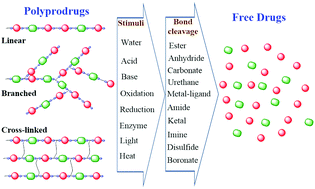Degradable polyprodrugs: design and therapeutic efficiency
Abstract
Prodrugs are developed to increase the therapeutic properties of drugs and reduce their side effects. Polyprodrugs emerged as highly efficient prodrugs produced by the polymerization of one or several drug monomers. Polyprodrugs can be gradually degraded to release therapeutic agents. The complete degradation of polyprodrugs is an important factor to guarantee the successful disposal of the drug delivery system from the body. The degradation of polyprodrugs and release rate of the drugs can be controlled by the type of covalent bonds linking the monomer drug units in the polymer structure. Therefore, various types of polyprodrugs have been developed based on polyesters, polyanhydrides, polycarbonates, polyurethanes, polyamides, polyketals, polymetallodrugs, polyphosphazenes, and polyimines. Furthermore, the presence of stimuli-responsive groups, such as redox-responsive linkages (disulfide, boronate ester, metal-complex, and oxalate), pH-responsive linkages (ester, imine, hydrazone, acetal, orthoester, P–O and P–N), light-responsive (metal-complex, o-nitrophenyl groups) and enzyme-responsive linkages (ester, peptides) allow for a selective degradation of the polymer backbone in targeted tumors. We envision that new strategies providing a more efficient synergistic therapy will be developed by combining polyprodrugs with gene delivery segments and targeting moieties.



 Please wait while we load your content...
Please wait while we load your content...